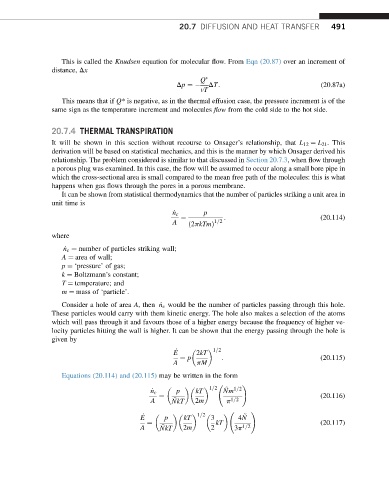Page 499 - Advanced thermodynamics for engineers
P. 499
20.7 DIFFUSION AND HEAT TRANSFER 491
This is called the Knudsen equation for molecular flow. From Eqn (20.87) over an increment of
distance, Dx
Q
Dp ¼ DT: (20.87a)
vT
This means that if Q* is negative, as in the thermal effusion case, the pressure increment is of the
same sign as the temperature increment and molecules flow from the cold side to the hot side.
20.7.4 THERMAL TRANSPIRATION
It will be shown in this section without recourse to Onsager’s relationship, that L 12 ¼ L 21 .This
derivation will be based on statistical mechanics, and this is the manner by which Onsager derived his
relationship. The problem considered is similar to that discussed in Section 20.7.3, when flow through
a porous plug was examined. In this case, the flow will be assumed to occur along a small bore pipe in
which the cross-sectional area is small compared to the mean free path of the molecules: this is what
happens when gas flows through the pores in a porous membrane.
It can be shown from statistical thermodynamics that the number of particles striking a unit area in
unit time is
_ n c p
¼ : (20.114)
A ð2pkTmÞ 1=2
where
_ n c ¼ number of particles striking wall;
A ¼ area of wall;
p ¼ ‘pressure’ of gas;
k ¼ Boltzmann’s constant;
T ¼ temperature; and
m ¼ mass of ‘particle’.
Consider a hole of area A, then _ n c would be the number of particles passing through this hole.
These particles would carry with them kinetic energy. The hole also makes a selection of the atoms
which will pass through it and favours those of a higher energy because the frequency of higher ve-
locity particles hitting the wall is higher. It can be shown that the energy passing through the hole is
given by
E _ 2kT 1=2
¼ p : (20.115)
A pM
Equations (20.114) and (20.115) may be written in the form
1=2 ~ 1=2 !
_ n c p kT Nm
¼ (20.116)
~
A NkT 2m p 1=2
~
E _ p kT 1=2 3 4N !
¼ kT (20.117)
~
A NkT 2m 2 3p 1=2

